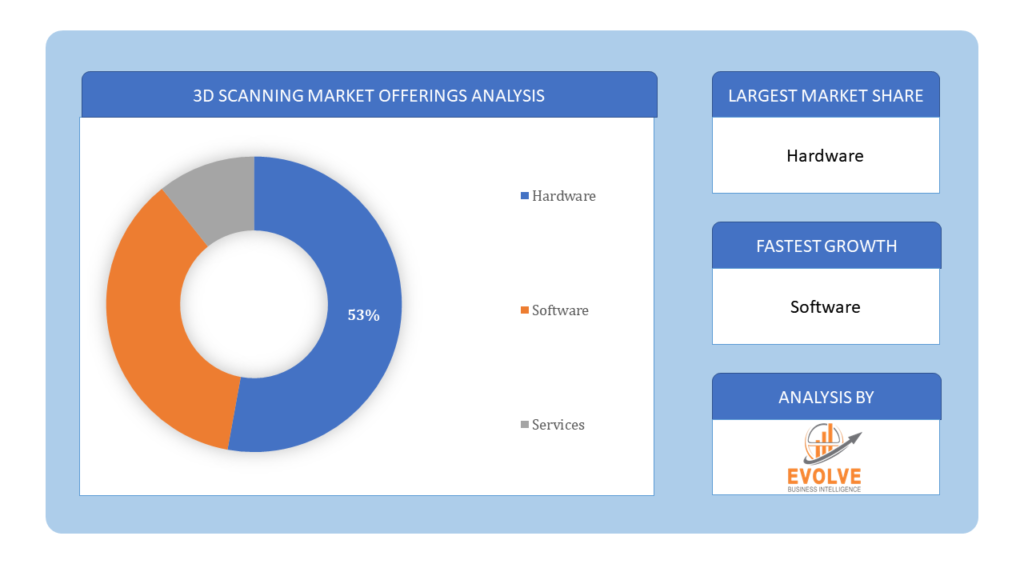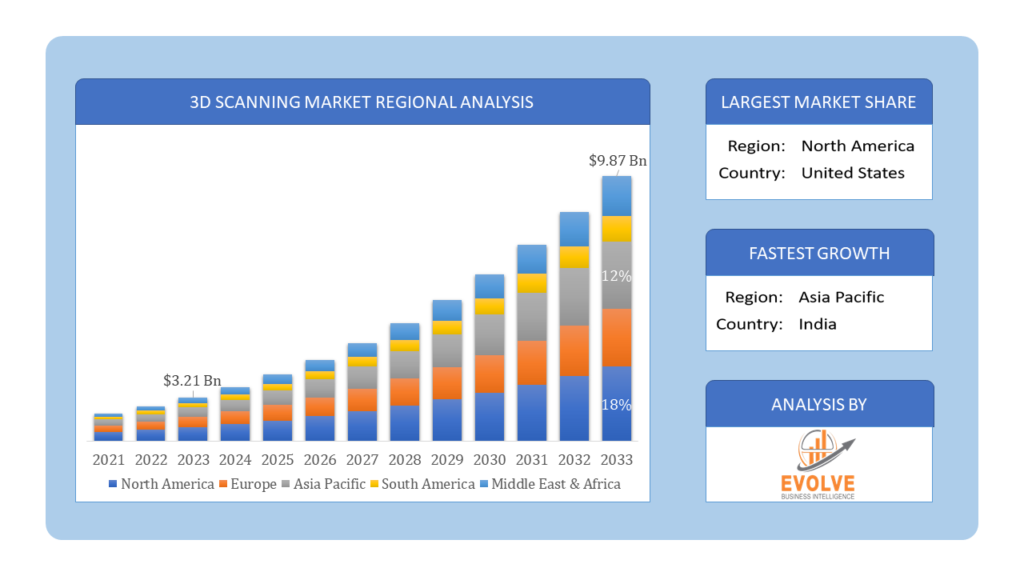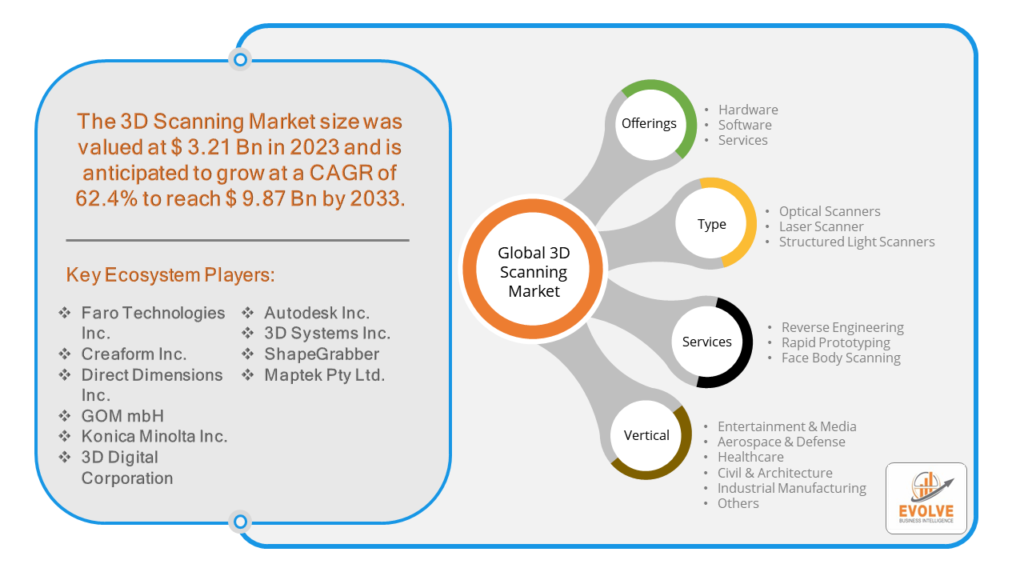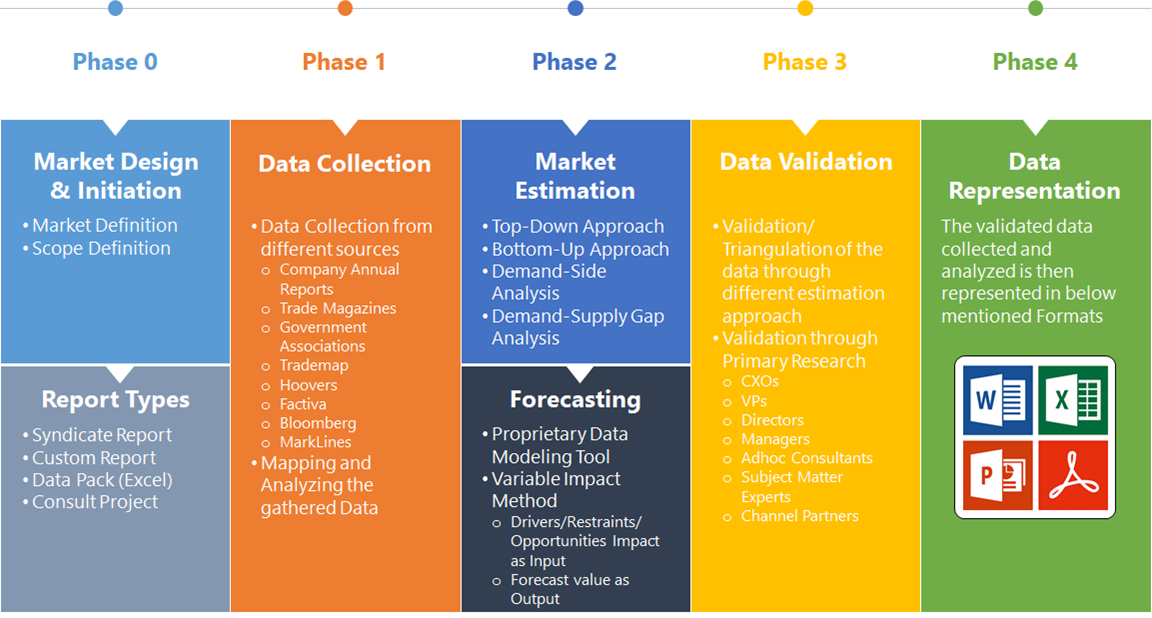3D Scanning Market Overview
The 3D Scanning Market Size is expected to reach USD 9.87 Billion by 2033. The 3D Scanning Market industry size accounted for USD 3.21 Billion in 2023 and is expected to expand at a compound annual growth rate (CAGR) of 10.74% from 2023 to 2033. The 3D scanning market refers to the industry involved in the production, distribution, and application of technology that captures the three-dimensional shape and appearance of objects and environments. This technology utilizes various methods such as laser, structured light, or photogrammetry to create digital representations of physical objects or spaces.
The Key players in the 3D scanning market include technology companies specializing in hardware (such as scanners and cameras), software developers providing processing and analysis tools, as well as service providers offering scanning services for industries and projects requiring precise 3D data acquisition. The market is driven by factors such as the increasing demand for 3D modeling and visualization in various industries, advancements in scanning technologies, and the growing adoption of 3D scanning for digital preservation and cultural heritage applications.
Global 3D Scanning Market Synopsis
The COVID-19 pandemic had significant impacts on the 3D scanning market. With restrictions on movement and in-person interactions, there has been a surge in demand for remote solutions across various industries. 3D scanning technology enables remote inspection, virtual tours, and digital documentation, thus witnessing increased adoption. The pandemic has highlighted the importance of digital technologies in healthcare. 3D scanning has been utilized in medical imaging, patient monitoring, and even in the development of personal protective equipment (PPE) and medical devices. Many manufacturing companies have accelerated their digital transformation efforts due to disruptions in the global supply chain. 3D scanning has been used for quality control, reverse engineering, and prototyping, aiding companies in adapting to new production methods. The economic uncertainty resulting from the pandemic may have led some businesses to postpone or scale back investments in new technologies, including 3D scanning equipment and services.
3D Scanning Market Dynamics
The major factors that have impacted the growth of 3D Scanning Market are as follows:
Drivers:
Ø Growing Demand for 3D Modeling and Visualization
Industries such as architecture, engineering, construction, and entertainment require accurate 3D models and visualizations for design, planning, and presentation purposes. 3D scanning provides a fast and efficient way to capture real-world objects and environments in high detail, driving its adoption in these sectors. Continuous advancements in hardware and software technologies have led to improvements in 3D scanning speed, accuracy, and ease of use. This has made 3D scanning more accessible to a wider range of industries and Applications, fueling market growth. The healthcare industry is increasingly adopting 3D scanning for Applications such as medical imaging, patient monitoring, surgical planning, and the customization of medical devices. 3D scanning technology allows for the creation of detailed anatomical models and aids in personalized treatment approaches.
Restraint:
- Perception of High Initial Investment Costs
The initial investment required for purchasing 3D scanning hardware and software can be significant, particularly for high-precision scanners and advanced software packages. Additionally, the cost of training personnel to operate and maintain 3D scanning systems adds to the overall expense. These high upfront costs can act as a barrier to entry for small and medium-sized businesses, constraining market growth, especially in sectors with limited budgets. 3D scanning generates large volumes of data, which can strain computational resources and require significant storage capacity. Processing and managing this data efficiently can be challenging, particularly for organizations with limited IT infrastructure or expertise. Additionally, ensuring data security and integrity throughout the scanning and processing workflow is crucial but can be resources-intensive.
Opportunity:
⮚ Integration with Emerging Technologies
3D scanning can be integrated with emerging technologies such as artificial intelligence (AI), machine learning, and the Internet of Things (IoT) to enhance capabilities and create new solutions. For example, AI-powered algorithms can automate data processing and analysis, while IoT sensors can enhance the accuracy and efficiency of scanning systems. The ability of 3D scanning to create detailed digital representations of objects and environments opens up opportunities for customization and personalization. This is particularly relevant in industries such as fashion, automotive, and consumer goods, where personalized products and experiences are in high demand. The concept of digital twins, virtual replicas of physical objects or systems, is gaining traction across various industries. 3D scanning plays a crucial role in creating and maintaining accurate digital twins, which can be used for predictive maintenance, simulation, and optimization, among other Applications.
3D Scanning Market Segment Overview
By Offerings
 Based on Offerings, the market is segmented based on Hardware, Software and Services. The hardware category is predicted to have the biggest market share. Also, technological advancement in 3D scanning sector drives the growth of the segment. Laser scanners emit laser beams onto the object’s surface and measure the time it takes for the laser to reflect back to the scanner. This data is then used to create a 3D point cloud, which forms the basis for the 3D model.
Based on Offerings, the market is segmented based on Hardware, Software and Services. The hardware category is predicted to have the biggest market share. Also, technological advancement in 3D scanning sector drives the growth of the segment. Laser scanners emit laser beams onto the object’s surface and measure the time it takes for the laser to reflect back to the scanner. This data is then used to create a 3D point cloud, which forms the basis for the 3D model.
By Type
Based on Type, the market segment has been divided into Optical Scanners, Laser Scanner and Structured Light Scanners. The laser Scanner category is expected to rise rapidly owing to increasing demand in various sectors. Furthermore, rapid development and innovation for launch of portable scanner drives the growth of this segment in forecast period.
By Range
Based on Range, the market segment has been divided into Short Range Scanner, Medium Range Scanner and Long Range Scanner. Short range 3D scanner anticipated to witness significant growth owing to increasing applications in healthcare and medical sector.
By Services
Based on Services, the market segment has been divided into Reverse Engineering, Rapid Prototyping and Face Body Scanning. Reverse Engineering segment is dominant the market. Reverse engineering begins with the digitization of physical objects using 3D scanning devices. These scanners capture the shape, size, and surface details of the object to create a digital point cloud or mesh.
By Vertical
Based on Vertical, the market segment has been divided into Entertainment & Media, Aerospace & Defense, Healthcare, Civil & Architecture, Industrial Manufacturing and Others. The healthcare sector drives the growth of market. During the projected period, the healthcare segment is expected to rise rapidly owing to increasing adoption of 3D scanners in various medical applications such as body scanning and others.
Global 3D Scanning Market Regional Analysis
Based on region, the global 3D Scanning Market has been divided into North America, Europe, Asia-Pacific, the Middle East & Africa, and Latin America. North America is projected to dominate the use of the 3D Scanning Market followed by the Asia-Pacific and Europe regions.
 3D Scanning North America Market
3D Scanning North America Market
North America holds a dominant position in the 3D Scanning Market. North America, particularly the United States, holds a significant share of the global 3D scanning market. The region benefits from a strong presence of key market players, robust technological infrastructure, and a high level of adoption across various industries such as automotive, aerospace, healthcare, and entertainment. Canada also contributes to market growth, particularly in industries like manufacturing and engineering.
3D Scanning Asia-Pacific Market
The Asia-Pacific region has indeed emerged as the fastest-growing market for the 3D Scanning Market industry. Asia-Pacific is experiencing rapid growth in the 3D scanning market, fueled by factors such as industrialization, urbanization, and technological advancements. China, with its booming manufacturing sector, is a major contributor to market growth, particularly in automotive, electronics, and construction industries. Japan and South Korea are also significant markets, driven by advanced technology adoption and Applications in automotive, healthcare, and entertainment sectors.
Competitive Landscape
The global 3D Scanning Market is highly competitive, with numerous players offering a wide range of software solutions. The competitive landscape is characterized by the presence of established companies, as well as emerging startups and niche players. To increase their market position and attract a wide consumer base, the businesses are employing various strategies, such as product launches, and strategic alliances.
Prominent Players:
- Faro Technologies Inc.
- Creaform Inc.
- Direct Dimensions Inc.
- GOM mbH
- Konica Minolta Inc.
- 3D Digital Corporation
- Autodesk Inc.
- 3D Systems Inc.
- ShapeGrabber
- Maptek Pty Ltd.
Key Development
In May 2021, Nikon launched updated Metrology’s industrial microfocus X-ray CT inspection solutions with added offset CT reconstruction algorithm for fast 3D data with accurate image resolution.
In March 2021, Creaform announced the latest addition the SILVER series to its HandySCAN 3DTM line-up portfolio. The SILVER Series is designed to capture supreme accurate and repeatable 3D estimation of any challenging surface.
In October 2020, Trimble signed strategic business partnership with Boston Dynamics to integrate a numerous construction data collection technologies of Trimble with Boston Dynamics’ Spot® robot platform for enhanced site scans, improved surveying, progress monitoring solution, along with and GNSS technologies.
Scope of the Report
Global 3D Scanning Market, by Offerings
- Hardware
- Software
- Services
Global 3D Scanning Market, by Type
- Optical Scanners
- Laser Scanner
- Structured Light Scanners
Global 3D Scanning Market, by Range
- Short Range Scanner
- Medium Range Scanner
- Long Range Scanner
Global 3D Scanning Market, by Services
- Reverse Engineering
- Rapid Prototyping
- Face Body Scanning
Global 3D Scanning Market, by Vertical
- Entertainment & Media
- Aerospace & Defense
- Healthcare
- Civil & Architecture
- Industrial Manufacturing
- Others
Global 3D Scanning Market, by Region
- North America
- US
- Canada
- Mexico
- Europe
- UK
- Germany
- France
- Italy
- Spain
- Benelux
- Nordic
- Rest of Europe
- Asia Pacific
- China
- Japan
- South Korea
- Indonesia
- Austalia
- Malaysia
- India
- Rest of Asia Pacific
- South America
- Brazil
- Argentina
- Rest of SouthAmerica
- Middle East &Africa
- Saudi Arabia
- UAE
- Egypt
- SouthAfrica
- Rest of Middle East & Africa
| Parameters | Indicators |
|---|---|
| Market Size | 2033: $9.87 Billion |
| CAGR | 10.74% CAGR (2023-2033) |
| Base year | 2022 |
| Forecast Period | 2023-2033 |
| Historical Data | 2021 |
| Report Coverage | Revenue Forecast, Competitive Landscape, Growth Factors, and Trends |
| Key Segmentations | Offerings, Type, Range, Services, Vertical |
| Geographies Covered | North America, Europe, Asia-Pacific, Latin America, Middle East, Africa |
| Key Vendors | Faro Technologies Inc., Creaform Inc., Direct Dimensions Inc., GOM mbH, Konica Minolta Inc., 3D Digital Corporation, Autodesk Inc., 3D Systems Inc., ShapeGrabber and Maptek Pty Ltd. |
| Key Market Opportunities | • Integration with Emerging Technologies • Digital Twin Development |
| Key Market Drivers | • Growing Demand for 3D Modeling and Visualization • Increasing Applications in Healthcare and Medical Imaging |
REPORT CONTENT BRIEF:
- High-level analysis of the current and future 3D Scanning Market trends and opportunities
- Detailed analysis of current market drivers, restraining factors, and opportunities in the future
- 3D Scanning Market historical market size for the year 2021, and forecast from 2023 to 2033
- 3D Scanning Market share analysis at each product level
- Competitor analysis with detailed insight into its product segment, Government & Defense strength, and strategies adopted.
- Identifies key strategies adopted including product launches and developments, mergers and acquisitions, joint ventures, collaborations, and partnerships as well as funding taken and investment done, among others.
- To identify and understand the various factors involved in the global 3D Scanning Market affected by the pandemic
- To provide a detailed insight into the major companies operating in the market. The profiling will include the Government & Defense health of the company’s past 2-3 years with segmental and regional revenue breakup, product offering, recent developments, SWOT analysis, and key strategies.





